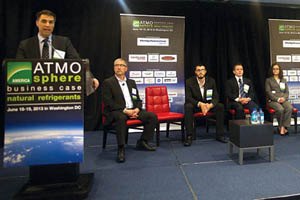
|
| Participants for a discussion on natural refrigerants are, from left, Benoit Radier of Cimco, at podium; Brian Porter of Blissfield; Jim Hower of Danfoss; Derek Hamilton of Star Refrigeration; Ilana Camber and Preston Blay of BAC; John Hipchen of Exel Consulting; and Michael Englebright of Carel. |
The purpose of the Atmosphere America event in Washington, D.C., this past summer was to present a business case for so-called natural refrigerants like R-290 (propane), R-600a (isobutene), R-717 (ammonia), and R-744 (CO2), among others.
In that context, the concern was not so much in regulatory action against f-gases, but that naturals could provide cost-effective refrigeration and cooling solutions. The purpose of the case histories was to show real-world applications with measureable results.
In Control of R-744
Michael Englebright, global key accounts manager, Carel, presented on the “Sustainability of CO2 Technology and the Role of Control Systems,” which examined improvements regarding such refrigerants in secondary systems.
For example, regarding secondary systems developed in the 1990s, he said there were advantages (reduced refrigerant charge, applications on the high side, use with brine, and a wide acceptance by retailers), along with what he called ‘barriers’ (high energy regarding pumps, maintenance costs, and efficiency losses).
The early 2000s, he said, brought subcritical cascade with its pluses (reduced refrigerant charge, advancement in controls, and medium-temperature evaporator efficiency improvements), but still with some barriers (cabinet evaporator development, pump flow and capital costs, as well as a need for training of installers and technicians). But, with the recent development of transcritical booster SX systems, there comes, he said, use of a single refrigerant, evaporator optimization, medium- and low-temp COPs [coefficient of performance], and hot gas defrost — while still dealing with issues related to such systems being used in warmer climates, capital costs, and training.
“The main barriers (now) are training and education,” he said. “In emerging countries there is a need for centralized training, and industry support (in training) is a must.” He noted the need for e-learning platforms as well as hands-on training.
Focusing on some specifics, he said, “An additional benefit which CO2 systems deliver is utilization of useful heat. There is integrated management of heat pump valves during the defrost requirements, and there is a swift, short defrost duration.”
He noted, “Research results today demonstrate that applying a CO2 transcritical ejector in the system is a promising method to increase system efficiency.”
Mainstreaming CO2/Ammonia Systems
The use of ammonia and CO2 in a system is a mainstream solution for creating refrigeration, according to presenters Benoit Rodier, director of business development, Cimco Refrigeration and Jim Hower, industrial refrigeration sales manager, Danfoss. They specifically looked at it for use in a Canadian distribution facility for fruits and vegetables. “Reaching this correct balance dictated its future direction of warehousing and delivery freshness,” the presenters said.
The presentation focused on what Hower and Rodier called simplicity and reliability for the system.
It was noted, “The ammonia charge is relatively small and restricted to the engine room only. CO2 pumped emphasizes simplicity, control, and maintenance of modern plants. NH3/CO2 components are readily available for 754 psig, making design and construction accessible to OEMs and contractors.”
The result was a “wide range of room temperatures from one CO2 temperature loop, faster pull downs, limited ammonia charge, and easy startup — within 48 hours.”
This results in what the presenters called a “formula for repeated success” when “supplier’s help and support is crucial, a project is scalable and repeatable and (there is) an integrated approach with measureable results.”
Transcritical Trends
The trend toward transcritical CO2 systems is becoming “reliable, affordable, and more efficient,” said Brian Porter, corporate director of sales, Blissfield Mfg., who discussed double-stage transcritical compressors.
“This new range (of compressors) features a wide operating envelope being suitable for many applications,” he said. “This two-stage technology allows for several advantages such as split low- and high-temperature systems in typical rack applications so you have less risk. You get the advantage of floating heat pressure also for low-temperature units. There is heat pump operation for low-temperature ambient thanks to high maximum speed.”
He noted, “Two-stage compressors offer interesting solutions to decrease supermarkets’ capital and running costs.”
Propane in Room Air Conditioning
The development of a low-charge propane room air conditioner using smaller-diameter copper tubes was presented by John Hipchen, president, Exel Consulting Group, on behalf of its author, Wenson Zheng, of Copper Alliance Asia.
He noted, “China has aggressively and successfully combined MicroGroove small-diameter copper tube technology with R-290 refrigerant in window and room air conditioners.” He noted that Chinese OEMs are using MicroGroove technology in RAC systems both within the country and for export.
He asked, “Can R-290 MicroGroove RAC in North America be far behind? With R-290-approved by the U.S. Environmental Protection Agency’s (EPA) Significant New Alternative Program (SNAP) and R-290 costs a fraction of R-22 and R-134a, significant reductions in refrigerant charge from MicroGroove technology can make R-290 systems economically viable in North America.” He did say the flammability aspect of R-290 is a concern.
Publication date: 9/2/2013
Want more HVAC industry news and information? Join The NEWS on Facebook, Twitter, and LinkedIn today!



Report Abusive Comment